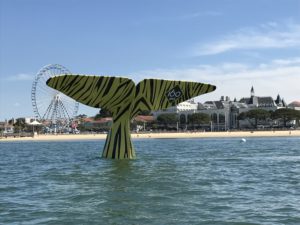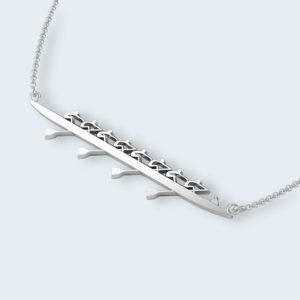

Ben Hunt-Davis was one of the Men’s Eights British rowing team who won gold in the Sydney Olympics in 2000, the first British winners of the rowing since 1912. Before that, he had rowed for almost a decade in which he had competed in three Olympic Games and six World Championships.
After achieving his ultimate goal in his rowing career, Ben retired and has spent the last 7 years running a company called Point8 Coaching which helps individuals in business to improve their performance.
Also the author of the latest addition to our book shop Will it make the boat go faster?, caught up with us for an interview to talk a bit more about rowing.
How many times a week did you do Rowperfect sessions?
After 1998 we started to train differently. We did more sessions on rowing machines, essentially one a day would always be on RP for 16, 20 or 12 km. In the boathouse in Hammersmith we had along one wall we had 5/6 C2s and there were two tucked in behind and two Rowperfects. We only had two and we took it in turn on them we’d do 10k and have 1 mins break and then swap. As an individual you would be on it twice a week and some people pushed to use them more often.
What was different in the winter versus during the racing season?
One of the reasons we did more ergo work was because previously in the 8 we found it hard to get everyone’s heart rate at the right level all the time while training on the water. Some people never got their heart rate up to the right level. Machines would guarantee your fitness improving because everyone could make sure their heart rate was right. The coaches, wanted to make sure the sessions on RP weren’t just physical. They were technical sessions –for the C2 we had to ensure the fan noise and rhythm was right and the hand speeds and feet movement. On the RP we had to make sure the force curve was the right shape and right movement off the feet.
Did you train using the Rowperfect force curves?
We were very aware of getting the oars in and out at the same time wasn’t enough to win the Olympics, we had only one way of measuring everyone had the same force so the power was coming on quickly and maintained long enough. It was the only tool we had to check this. There is a template curve from Lewis Attrill or Kieran West we used. [Download famous athletes’ force curves for use on RPW and RP3W software here https://www.rowperfect.co.uk/rowperfect-force-curves/ ]
What did you personally learn from the Rowperfect?
One of the key things I worked on was opening my back properly against my legs to get my force curve shape right. In the warm up tent we had at the Olympic Games we had 2 Rowperfects and one of the things I spent a lot of time doing was sitting on RP to make sure I was doing it correctly. The force curve shape was an immediate check. Then also making sure hand speed correct around the finish and we were connecting hands and feet properly at the catch…. how far you slide up and down was dictated by hand speeds.
Did you use drills and exercises?
Not really – we spent a lot of time on RPs with feet out.. It was more doing the distance and being coached to make sure the volume of the curve was right. Doing it individually was relatively easy – when we strapped two RPs together it became quite hard. We might spend first few minutes individually and then strap them together – we had different pairings… I didn’t row as well as I wanted to and I found the pairings harder to do. You had to be so precise with how you were moving on the recovery and how you were starting the drive to make it work. I did a lot with Bob Thatcher and we were bow pair for a long time – we managed to do it pretty successfully – when we swapped different pairings down the boat it was harder.
You talk in the book about ‘moving away’ from Jurgen Grobler’s training system. What was different about Martin and Harry’s training system?
Their programme was designed for us rather than the four. Some of the differences – if you’re in a pair it’s easy to get the heart rate right every session. That’s one of the reasons we did more on the machines. Jurgen’s corner stones were lactate sessions – weights circuits. Because Martin felt they weren’t muscle specific and we didn’t have time to do it so we did 10 minutes on machines instead to make it more specific. Jurgen has some technical sessions in his programme – we had probably more technical sessions where we went out and just did drills because we needed it. After hte 1999 Worlds and through the season we had the fastest middle 1000m in the race. And a mediocre start. So became clear if we wanted to win the Olympics we needed the fasted first 500. Every session on the water ended with one or two starts. The training programme was to develop core power to get us out of the blocks faster… the whole focus of the programme was on this. Jurgen’s programmes were never designed like this.
Did the coaches take technique and skill drills from the boat onto the Rowperfect and back again? Which ones?
Not necessarily the same drills but there was a lot of focus on technique on the machines. The boat drills wouldn’t transfer e.g. feet out to make sure we were moving round the back turn correctly and our feet were staying connected. We did on the machine lifting our hands and getting pressure on the feet to make sure the catch shape at the catch was the same on the machine and the boat. Drills in the boat included – single strokes; doing the front quarter / half of the stroke making sure upper body and back was staying still just moving our hands and picking it up on the legs…. there were sessions of Harry just getting us to row in circles… one person rowing individually to make sure we were doing what he wanted us to do. I remember at the ‘99 worlds doing one lap of the course we did 250m each time we’d try and row like a different nation… Romanians, Russians, Americans… it was great fun to translate what we were seeing on the lake to how that felt and then going back to how we wanted to row.
Technically we would decide we wanted to work on something like lifting the hands, or moving the back – we’d take an element of the stroke and for one week or 10 days we’d spend time doing nothing but that one element. And then when the coaches decided we’d play word games and number games up and down the boat to take the focus away from anything we’d being thinking technically – it relaxes you and you forget about rowing and thinking about word association.
I heard that the crew used Rowperfects during each race warm up and preparation. What did you do?
I remember sitting on it not doing a huge distance just handfuls of strokes to make sure my back was opening against my legs properly and it was there as a tool to make sure we go the force curve right when we got onto the water. We did some pairs and moved down the boat – stern pair and next pair. We made sure we did it with other pairs in the boat.
Do you have any advice for coaches considering using Rowperfect for their athletes and crews?
I’d say one of the key things to start with is to have a good understanding of what your boat class force curve should look like. From a 1x to an eight the shape is going to be different. Firstly when you stick athletes on RP for the first time have a template of that athlete’s boat class so you know what you’re trying to do and the athlete knows too. I think that very often rowing machines are seen as a way to work really hard. If coaches get athletes only to work hard they are missing out on so much.
There’s so much more you can do on a rowing machine. For example if you break the elements down of what makes up a rowing outing – it’s technical, physical and mental. On rowing machines you should be doing the technical and mental part as much as the physical. Your athletes should be as tired mentally and technically as physically after a session. … on a RP if you can get athletes in a crew boat to have their RPs linked so they can row with anyone else in the boat well. If they can do it [on RP] effectively with feet out and matched force curves they’ll probably go fast in the boat. You have to be far cleverer to use a RP… they are harder to use but it means what you’re doing translates into the boat far more effectively – make sure you’re using it as cleverly as you can so it links to the boat it isn’t just a “work hard” tool.
What was the aim for the Sydney Olympic Eight?
We knew we wouldn’t be the strongest crew who raced the Olympics on the water and our aim was to be the most technically skilled in the world.
In our eight one of the clearly stated aims was to technically be the best crew in the world. I don’t think we managed it but when we went to regattas and training camps we took a couple of RPs with us because we thought they were really useful tools to help us row better.








This Post Has 2 Comments
Great article, with some interesting insights into how the Sydney 8+ squad intergrated the rowperfect into their training, hope to continue to see more articles like this
Thanks Tom – we are working on creating a whole new section on coaching. You will have noticed some articles on how to video your crews written by Raf Wyatt.
As an experienced (elite) athlete, would you find articles on technique, training programmes, skill drills, race strategies etc helpful? What else?
Do you think we should call it something other than coaching – since I think it applies equally to interested athletes as well as coaches?